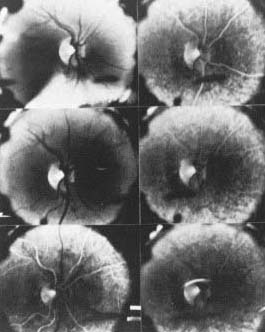The First Human Fluorescein Angiogram

In the late 1950's, a senior medical student named Harold Novotny and an intern named Dr. David Alvis were working with Dr. John Hickam, Chairman of the Department of Medicine at the Indiana University, on determining the oxygen saturation in retinal arterioles by a photographic method. Dr. Novotny began to think about passing some kind of dye through the system to determine saturation levels. It was thought that the observation of fluorescence might make it easier to make that determination, and sodium fluorescein was one of the dyes used. Dr. Alvis mixed a sample of his blood with a drop of fluorescein and shipped it to the Eli Lilly Company for analysis on a spectrofluorometer to determine the peak excitation and emittance wavelengths. A Kodak filter book was used to choose appropriate exciter and barrier filters. Dr. Alvis reportedly lost the toss of a coin, and became the first "guinea pig". Novotny and Alvis began performing fluorescein studies on diabetic patients, and individuals with hypertension. They submitted their work to the American Journal of Ophthalmology in 1960, but it was rejected because of similar work with cinematography published by Dr. Milton Flocks and co-workers. They presented their technique for photographing fluorescence at the Association for Research in Ophthalmology on April 23, 1960, and an abstract appeared in the American Journal of Ophthalmology in July, 1960. In July of 1961, the first published description of the technique appeared in Circulation. References Novtny HR, Alvis DL: A method of photographing fluorescence in circulating blood of the human eye (abstract), Am J. Ophthalmol. 50:176, 1960. Novtny HR, Alvis DL: A method of photographing fluorescence in circulating blood in the human retina, Circulation 24:82, 1961. Photograph furnished by Timothy J. Steffens, CRA The Indiana University Department of Ophthalmology |
